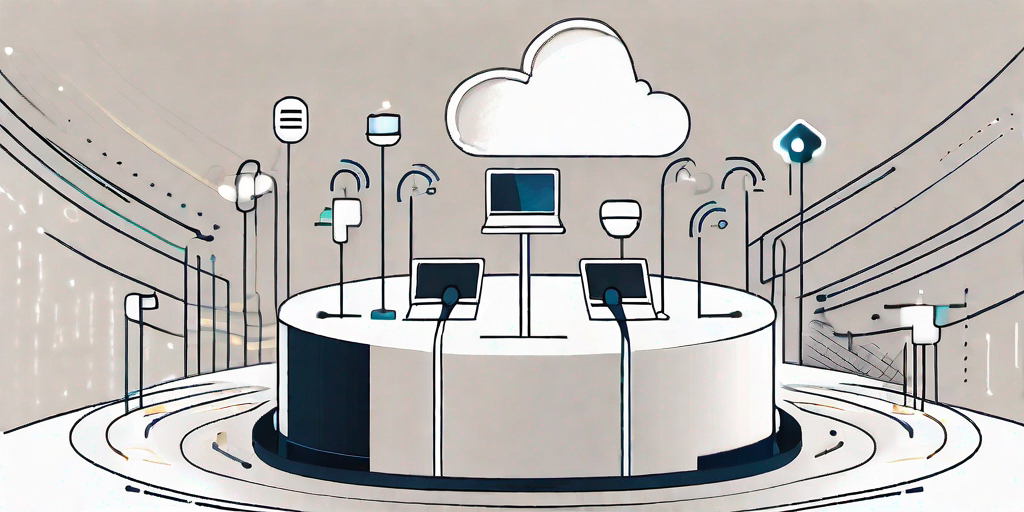Strategy Keynote Speaker: Understanding Edge Computing Aid

Strategy Keynote Speaker: Understanding Edge Computing Aid
Edge computing is revolutionizing the way we approach digital strategies and business operations. With its potential to enhance connectivity, reduce latency, and enable real-time data processing, it has become a critical component in the evolution of technology-driven industries. In this article, we will delve into the various aspects of edge computing and how a strategy keynote speaker can aid in understanding and leveraging its capabilities to gain a competitive advantage.
Understanding the Basics of Edge Computing
To comprehend the value proposition of edge computing, one must first understand its fundamentals. At its core, edge computing is a decentralized approach to data processing, in contrast to the traditional centralized model. It involves bringing computational resources closer to the data source, enabling real-time analysis and decision-making.
Edge computing is a concept that has gained significant attention in recent years due to the increasing demand for faster and more efficient data processing. In the traditional centralized model, data is sent to a remote data center for processing and analysis. This approach often results in delays and increased network latency, especially when dealing with large amounts of data.
By minimizing the distance that data needs to travel, edge computing reduces network latency and enhances overall system performance. This is particularly beneficial in scenarios where low latency and high bandwidth are critical, such as autonomous vehicles, IoT devices, and real-time analytics.
Autonomous vehicles, for example, rely on edge computing to make split-second decisions based on real-time data. By processing sensor data locally, these vehicles can quickly analyze their surroundings and react accordingly, without relying on a remote data center. This not only improves the safety and reliability of autonomous vehicles but also enables faster response times, which are crucial in critical situations.
Similarly, IoT devices heavily rely on edge computing to handle the massive amount of data generated by sensors and connected devices. By processing data at the edge, these devices can filter and analyze the data locally, sending only relevant information to the cloud for further processing. This reduces the amount of data that needs to be transmitted over the network, minimizing bandwidth requirements and improving overall system efficiency.
Real-time analytics is another area where edge computing shines. By bringing computational resources closer to the data source, organizations can perform real-time analysis on streaming data, enabling faster insights and immediate decision-making. This is particularly valuable in industries such as finance, healthcare, and manufacturing, where timely data analysis can lead to significant competitive advantages.
In conclusion, edge computing is a decentralized approach to data processing that brings computational resources closer to the data source. By reducing network latency and enhancing system performance, edge computing enables real-time analysis and decision-making, making it a crucial technology in various industries.
Strategy Keynote Speaker's Approach to Decoding Edge Computing
Decoding edge computing can be a complex task, especially for organizations looking to adopt this technology into their existing infrastructure. This is where a strategy keynote speaker shines; they excel in simplifying intricate concepts and making them accessible to a diverse audience.
A skilled strategy keynote speaker will break down the intricacies of edge computing, explaining its benefits, potential use cases, and the value it can bring to businesses. They articulate the concepts in a relatable manner, drawing on real-world examples and practical insights that resonate with both technical and non-technical decision-makers.
When it comes to understanding edge computing, it is important to grasp its fundamental principles. Edge computing refers to the practice of processing and analyzing data at or near the source of its generation, rather than sending it to a centralized cloud or data center. By bringing computation and data storage closer to the devices and sensors that generate the data, edge computing enables faster response times, reduced latency, and improved efficiency.
One of the key benefits of edge computing is its ability to support real-time decision-making. By processing data locally, organizations can make critical decisions instantaneously, without relying on a remote server or cloud infrastructure. This is particularly valuable in industries such as manufacturing, logistics, and healthcare, where split-second decisions can have a significant impact on operations and outcomes.
Furthermore, edge computing offers enhanced data privacy and security. By keeping sensitive data within the local network, organizations can minimize the risk of data breaches and unauthorized access. This is especially important in sectors dealing with sensitive information, such as finance, government, and healthcare.
When discussing the potential use cases of edge computing, the strategy keynote speaker will delve into various industries and highlight how this technology can revolutionize their operations. For example, in the retail sector, edge computing can enable personalized shopping experiences by analyzing customer data in real-time and delivering targeted recommendations. In the energy sector, edge computing can optimize power distribution and enable predictive maintenance of infrastructure, leading to cost savings and improved reliability.
It is crucial for organizations to understand the value that edge computing can bring to their businesses. The strategy keynote speaker will emphasize the competitive advantage that can be gained by embracing this technology. By leveraging edge computing, organizations can unlock new opportunities for innovation, improve operational efficiency, and gain a deeper understanding of their customers.
In conclusion, a strategy keynote speaker plays a vital role in decoding edge computing for organizations. Their ability to simplify complex concepts, provide relatable examples, and highlight the value of this technology makes them an invaluable resource for decision-makers. By embracing edge computing, organizations can stay ahead of the curve and harness its potential to drive growth and success.
Exploring the Impact of Edge Computing on Business Strategies
The impact of edge computing on business strategies cannot be overstated. It presents organizations with unprecedented opportunities to transform their operations, streamline processes, and gain a competitive edge in the digital landscape.
By leveraging edge computing, businesses can optimize their workflows, enhance data privacy and security, and enable real-time insights for improved decision-making. For example, retailers can utilize edge computing to personalize customer experiences in their brick-and-mortar stores, using real-time data analysis to offer tailored promotions and recommendations.
Moreover, edge computing enables organizations to unlock the power of emerging technologies like AI and machine learning. The ability to process data at the edge facilitates real-time AI inference, enabling autonomous systems, predictive maintenance, and intelligent anomaly detection.
One area where edge computing has shown significant impact is in the manufacturing industry. With the adoption of edge computing, manufacturers can revolutionize their production processes. By deploying edge devices and sensors throughout the factory floor, real-time data can be collected and analyzed at the edge, allowing for immediate adjustments and optimizations. This not only improves the overall efficiency of the manufacturing process but also reduces downtime and enhances product quality.
In the healthcare sector, edge computing has the potential to revolutionize patient care. With the increasing use of wearable devices and remote monitoring systems, healthcare providers can leverage edge computing to process and analyze patient data in real-time. This enables faster diagnosis, personalized treatment plans, and proactive healthcare interventions. Additionally, edge computing ensures data privacy and security, as sensitive patient information can be processed locally at the edge, reducing the risk of data breaches.
Edge computing is also transforming the transportation industry. With the rise of autonomous vehicles, edge computing plays a crucial role in enabling real-time decision-making and ensuring passenger safety. By processing data at the edge, autonomous vehicles can quickly analyze sensor inputs, make split-second decisions, and respond to changing road conditions. This not only enhances the reliability and efficiency of autonomous systems but also paves the way for the widespread adoption of self-driving cars.
Furthermore, the impact of edge computing extends beyond specific industries. It has the potential to revolutionize the way we interact with our cities and the environment. By deploying edge devices and sensors in urban areas, cities can collect and analyze real-time data on traffic patterns, air quality, energy consumption, and more. This data can then be used to optimize city infrastructure, reduce congestion, improve sustainability, and enhance the overall quality of life for residents.
In conclusion, edge computing is a game-changer for businesses across various industries. Its ability to process data at the edge enables real-time insights, enhances efficiency, and unlocks the potential of emerging technologies. As organizations continue to embrace digital transformation, edge computing will play a pivotal role in shaping their strategies and driving innovation.
How a Strategy Keynote Speaker Connects Edge Computing to Strategic Planning
Integrating edge computing into strategic planning requires a deep understanding of the technology's capabilities and potential business applications. A strategy keynote speaker can bridge this gap, helping organizations align their digital strategies with the possibilities offered by edge computing.
But what exactly is edge computing? Edge computing refers to the practice of processing and analyzing data at the edge of the network, closer to where it is generated, rather than sending it to a centralized cloud or data center. This approach offers several advantages, including reduced latency, improved security, and enhanced reliability. By bringing computation and data storage closer to the source, organizations can unlock new possibilities for real-time analytics, AI-driven decision-making, and IoT applications.
During a strategy keynote session, the speaker dives deep into the intricacies of edge computing, shedding light on its potential impact on various industries. They discuss real-world case studies and successful implementations, illustrating how edge computing can enhance operational efficiency, enable innovation, and drive growth.
For example, in the manufacturing sector, edge computing can revolutionize production processes by enabling predictive maintenance, real-time quality control, and optimized supply chain management. By analyzing data from sensors and machines in real-time, manufacturers can proactively identify potential issues, reduce downtime, and improve overall productivity.
In the healthcare industry, edge computing can play a crucial role in remote patient monitoring, telemedicine, and personalized healthcare. By leveraging edge devices and sensors, healthcare providers can collect and analyze patient data in real-time, allowing for early detection of health issues, timely interventions, and improved patient outcomes.
Furthermore, a strategy keynote speaker encourages organizations to think beyond the immediate benefits and consider the long-term implications of incorporating edge computing into their strategic plans. They emphasize the importance of aligning edge computing initiatives with broader digital transformation strategies, ensuring a holistic approach to technology adoption.
By leveraging edge computing, organizations can not only enhance their operational efficiency but also unlock new revenue streams and business models. The speaker highlights the potential for creating data-driven products and services, as well as the opportunities for collaboration and partnerships in the evolving edge computing ecosystem.
In conclusion, a strategy keynote speaker plays a vital role in connecting edge computing to strategic planning. Through their expertise and insights, they help organizations understand the transformative potential of edge computing and guide them in incorporating it into their long-term digital strategies. By embracing edge computing, organizations can stay ahead of the curve, drive innovation, and achieve sustainable growth in the digital age.
Leveraging Edge Computing for Competitive Advantage
To gain a competitive advantage, organizations must embrace emerging technologies and leverage them effectively. Edge computing provides a unique opportunity to do just that.
A strategy keynote speaker highlights the importance of not just adopting edge computing, but optimizing its potential for competitive advantage. They emphasize the need for a holistic approach, combining edge computing with other transformative technologies like cloud computing, big data analytics, and the Internet of Things.
Furthermore, a strategy keynote speaker encourages organizations to foster a culture of innovation and experimentation, empowering employees to explore creative use cases and solutions leveraging edge computing. By fostering a dynamic environment, businesses can stay ahead of the curve and reap the rewards of this transformative technology.
Conclusion
Edge computing is reshaping the digital landscape, and understanding its potential is crucial for organizations seeking a competitive edge. By engaging a strategy keynote speaker, businesses can navigate the complexities of edge computing, comprehend its impact on strategic planning, and unlock its full potential.
The partnership between a strategy keynote speaker and organizations looking to leverage edge computing can lead to groundbreaking innovations, streamlined operations, and a strategic advantage in the digital era.
As the technology landscape continues to evolve, the guidance of a strategy keynote speaker becomes increasingly valuable. By staying informed and utilizing the knowledge and insights they provide, organizations can position themselves at the forefront of technological advancements and secure a prosperous future.
FAQ
1. What is edge computing?
Edge computing is a decentralized approach to data processing that brings computational resources closer to the data source. It enables real-time analysis and decision-making by reducing network latency and enhancing system performance.
2. How can a strategy keynote speaker help in understanding edge computing?
A strategy keynote speaker can simplify the complexities of edge computing and make it accessible to a diverse audience. They explain the benefits, potential use cases, and value of edge computing through relatable examples and practical insights.
3. What is the impact of edge computing on business strategies?
Edge computing has a significant impact on business strategies. It enables organizations to optimize workflows, enhance data privacy and security, and enable real-time insights for improved decision-making. It also unlocks the potential of emerging technologies like AI and machine learning.
Contact a Strategy Keynote Speaker for Your Event
Dr Mark van Rijmenam, a renowned strategy keynote speaker, is available to enlighten and inspire at your next event. With a deep understanding of edge computing and its transformative power, Dr van Rijmenam can guide your organization through the complexities of this revolutionary technology. His expertise will enable you to comprehend the impact of edge computing on strategic planning and unlock its full potential for competitive advantage. If you're ready to navigate the digital landscape with confidence and secure a prosperous future for your organization, simply complete the form below. We promise to be in touch within 24 hours to discuss how Dr van Rijmenam can contribute to the success of your event.





